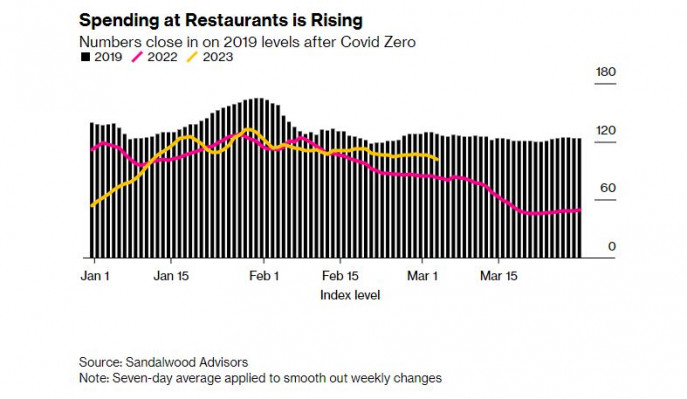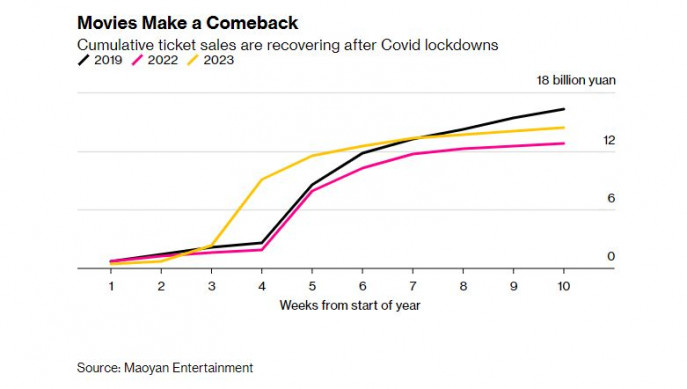Following the pandemic, China's 1.4 billion people are spending in the following ways.
Bloomberg || Shining BD
China is back after years of restrictions due to pandemics, but are its millions of customers?
The outcome of businesses, the likelihood of global inflation, and the possibility of a global economic recession are all impacted by the answer.
The rapid reversal of Covid Zero in mid-December set off a massive virus wave that the Chinese population is now recovering from. People are making travel plans, going out to eat, and going back to the malls.
However, despite the extreme pandemic measures and the accompanying economic uncertainties, people in the second-largest economy in the world aren't splurging as much as they once did.
How truly "open" is China?
We measure the ground's temperature three months later:
1. Meals and amusement
After three years of erratic restrictions that kept many Chinese consumers inside their homes, they are starting to venture outside once more.
Part of that can be observed in the rise in eating out. Restaurant spending is starting to return to pre-pandemic levels, but it hasn't yet exceeded them.

Haidilao, one of China's biggest hot pot restaurant chains, is estimated to have seen daily sales over the crucial Lunar New Year holiday period in January above where they were last year — when Covid curbs stopped many people from reuniting with their families.

Yet sales at restaurants serving the fiery broth, a popular communal dining activity, lagged far behind 2021, when the country was effectively in a bubble with China's borders shut to keep the virus out.
Fear of Covid among Chinese consumers is "dissipating," said Catherine Lim, Bloomberg Intelligence's senior analyst for consumer and technology. But concern over the outlook of the economy "is now prompting them to exercise greater caution in discretionary spending," she said.
The New Year break provided a burst of consumption in many sectors, but that momentum trailed off amid lingering concerns about Covid, rising flu cases and anxiety over where the economy is headed post-lockdowns.
That was seen clearly at the box office. Chinese flocked to movie theaters during the seven-day holiday, with ticket sales hitting 6.8 billion yuan ($990 million), up 15% from the same period of 2019.
But when looked at over a longer period, China's box office still trails pre-pandemic times. Sales in the first 10 weeks of 2023 climbed nearly 13% from last year, to more than 14 billion yuan, but were down 12% on 2019.

2. Shopping
Reliant on their phones to buy everything from food to apparel during the long Covid lockdowns, Chinese shoppers are hitting the streets once again. But some spending habits have changed — potentially for good.
Whether it's an overhang from the pandemic, or reflective of a more permanent trend, consumers are spending more on travel and purchases in the wellness sphere, from fitness equipment to sports club memberships and activities like meditation.
That could come at the expense of things like high-end fashion and expensive bags. China was the world's biggest source of luxury buyers pre-pandemic, so where this trend goes will be watched closely by companies from LVMH to Cartier owner Richemont.
There's also a divergence among generations.
Post-Covid, millennials — those born between 1981 and 1996 — are planning the biggest increase in spending on health and sports, according to data collected by international consultancy Oliver Wyman.
Meanwhile, baby boomers, the first generation in China to really embrace Western brands, are the least likely to be planning to splash out as the pandemic recedes, with their spending on luxury fashion set to drop the most this year, Oliver Wyman's survey showed.

"Prices of fast-moving consumer goods haven't started to pick up, signaling consumers are still cautious with their spending," said Jason Yu, managing director of Kantar Worldpanel Greater China, which is tracking the spending behavior of 40,000 families across the country. "There is definitely a noticeable recovery, but it is still not yet full scale."
And Chinese consumption is returning more slowly than it did in other places after they reopened.
The UK, for example, had lifted almost all its pandemic curbs by July 2021. By the week ending Sept. 25, overall retail footfall was 85% of what it was in the equivalent week of 2019, according to the country's statistics office.
"The biggest headwind to China's recovery is that consumer confidence has not yet recovered," said Larry Hu, head of China economics at Macquarie Group.
With China reluctant to give cash handouts to consumers to spur the recovery like in other parts of the world, a more sustainable rebound in sentiment and spending relies on stronger job creation. The labor market remains weak, though, with the latest data showing an increase in the jobless rate to 5.6% in February. The unemployment rate among young people was far worse, jumping to a six-month high of 18.1%.
3. Big-Ticket Items
China's reopening is slowly spurring people to return to real estate. Apartment sales rose 3.5% in January-February this year, after sliding 22% in the first two months of 2022.
A key engine of China's economy for more than a decade, the sector has been battered over the past year, with unfinished residences sitting empty across the country. The meltdown was fueled in part by Covid restrictions, and later the surge in cases that accompanied the reopening. Home sales dropped 27% in Dec. 2022 from the previous year, necessitating government support at the start of the year.

When it comes to another big purchase, though, Chinese consumers are more hesitant.
Car sales fell 9.4% in the first two months of 2023 on a year-on-year basis. A flooded market — China has more than 200 makers of electric cars, alone — has weighed on demand, with dealers resorting to slashing prices and offering cash incentives to entice buyers.
Automobile sales saw the biggest drop in the first two months of the year of all retail categories tracked by China's statistics bureau.

4. International Travel
China was the world's fastest-growing source of tourists pre-pandemic, and vacation spots from Thailand to Italy have felt their absence over the past three years.
The country's airports are busy again, with borders beginning to reopen on Jan. 8. But while the volume of international flights is higher than at the height of the Covid restrictions last year, it was still only 22% of pre-pandemic levels as of March 16, according to air traffic data tracker VariFlight.

Many overseas routes haven't resumed despite the scrapping of border curbs, and flights between China and the US remain capped at just 12 per week, a legacy of Covid-era curbs that saw international travel at a near-standstill. Both countries must approve the lifting of the cap, and there's little visibility on whether it will be increased anytime soon.
Some countries also still require negative Covid tests from Chinese travelers.
The pace of recovery is impacting some carriers. Spring Airlines, China's biggest budget carrier, said this month that demand for travel outside the country remains weak, inhibiting its recovery from the pandemic. The airline's international capacity is just 20% of pre-Covid levels. United Airlines has also delayed plans to add extra US-China flights until at least October.
The air travel rebound isn't just lagging because of limited flights. People need time to book trips abroad, with many countries requiring Chinese nationals to have visas, said Agnes Xu, co-founder and head of research at alternative data provider Sandalwood Advisors.
Three months from its abrupt abandonment of Covid restrictions, China is reopening — but more cautiously than other places, especially those that imposed fewer restrictions, sums up Hu at Macquarie.
"Compared with the US, China's post-Covid recovery is slower," he said. "The US had revenge spending that China does not have. Consumer confidence in the reopening phase of the US was much higher and the government gave out a lot of subsidies. China has neither."
"China's recovery is just beginning."
Shining BD
























